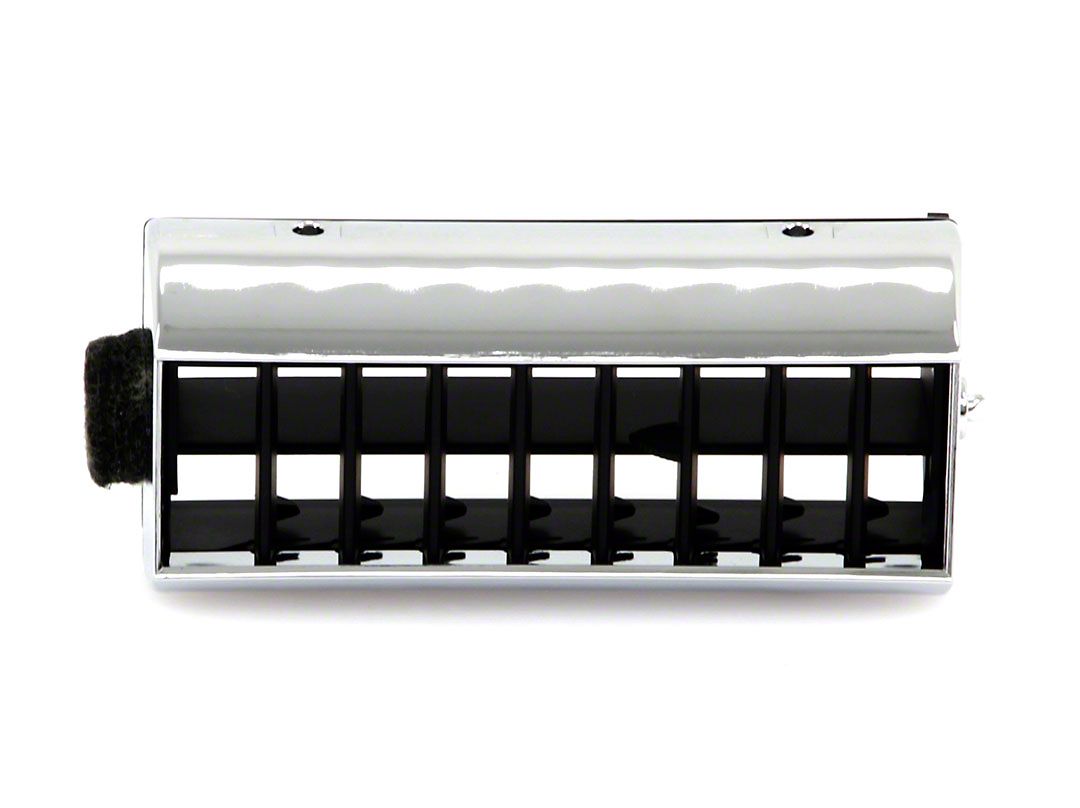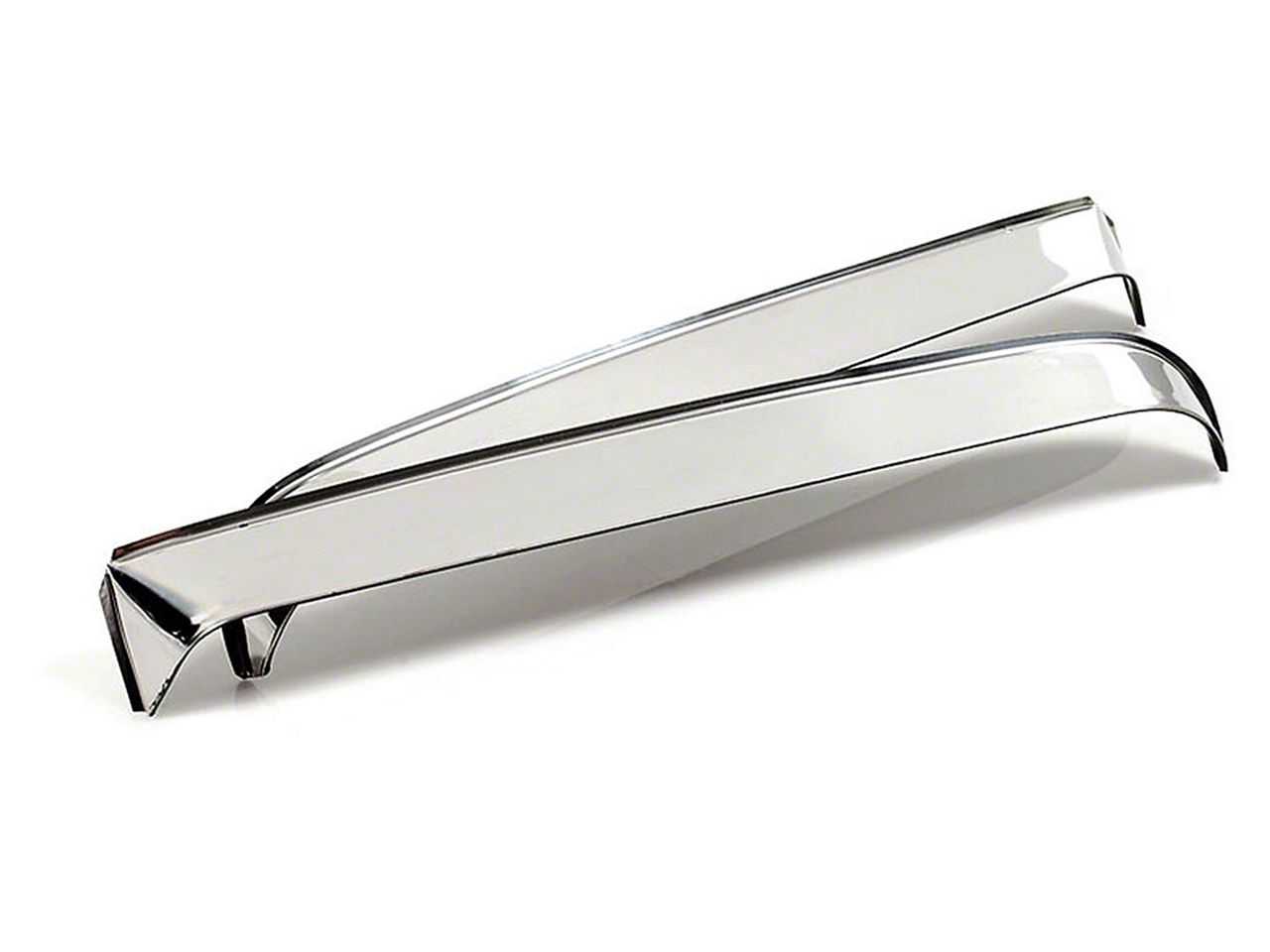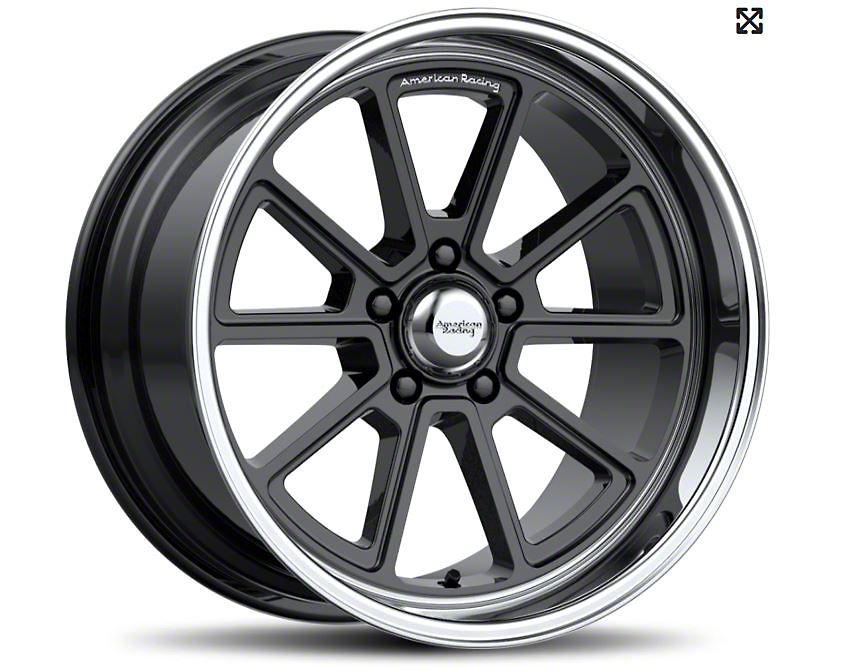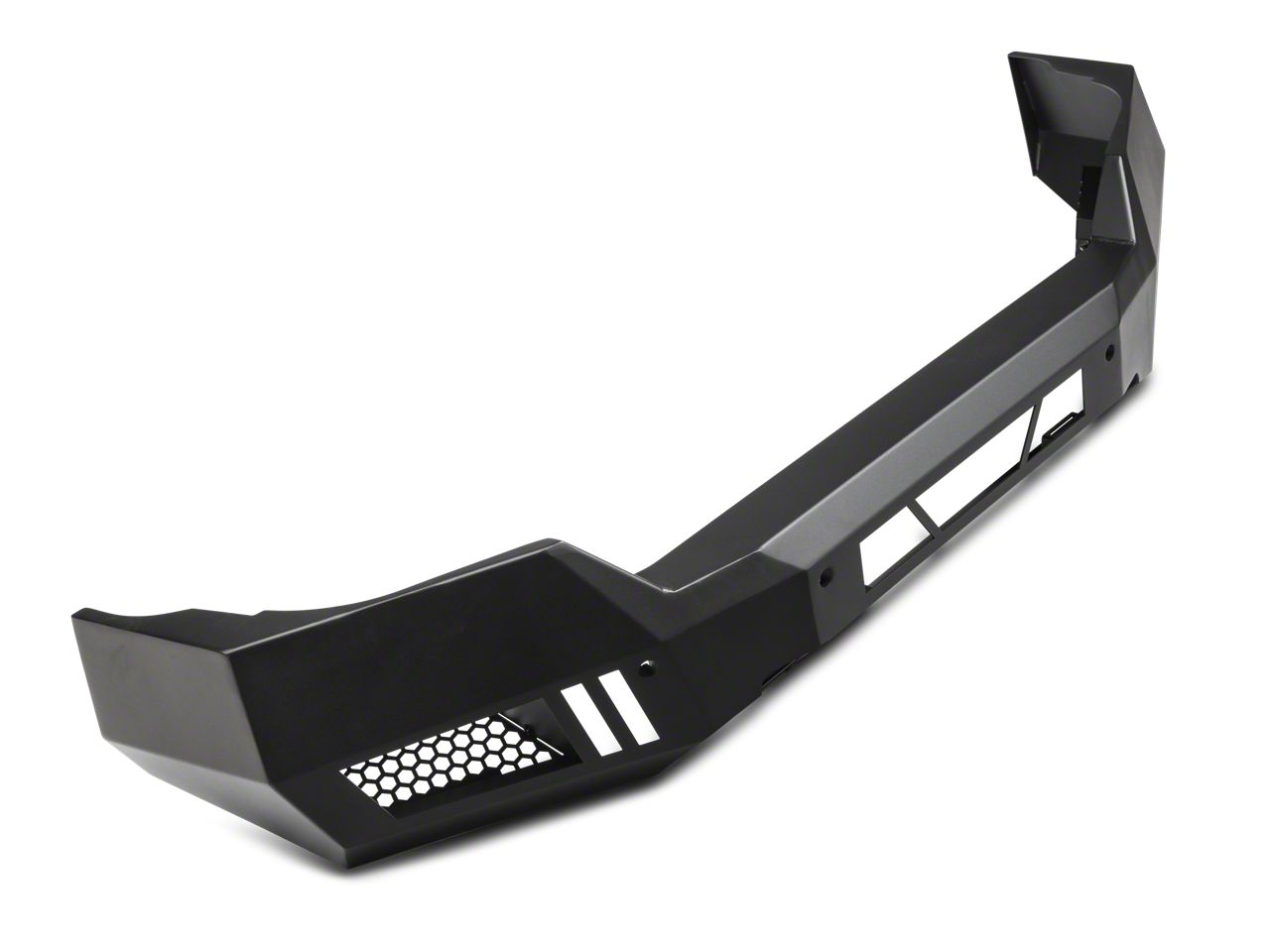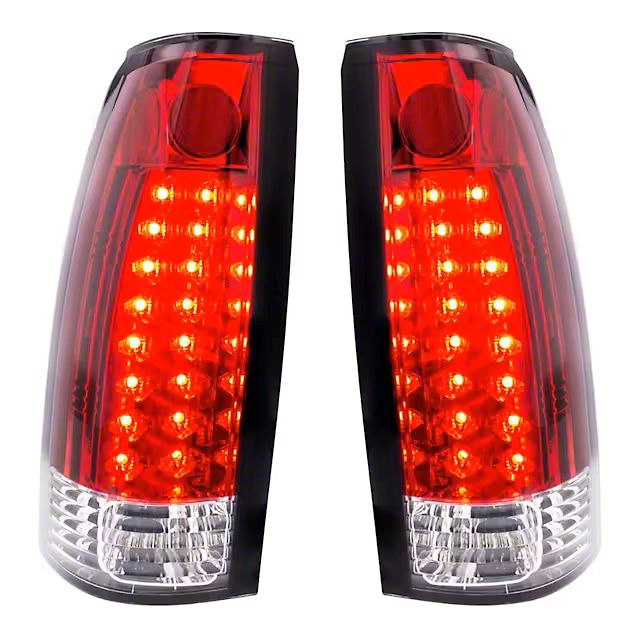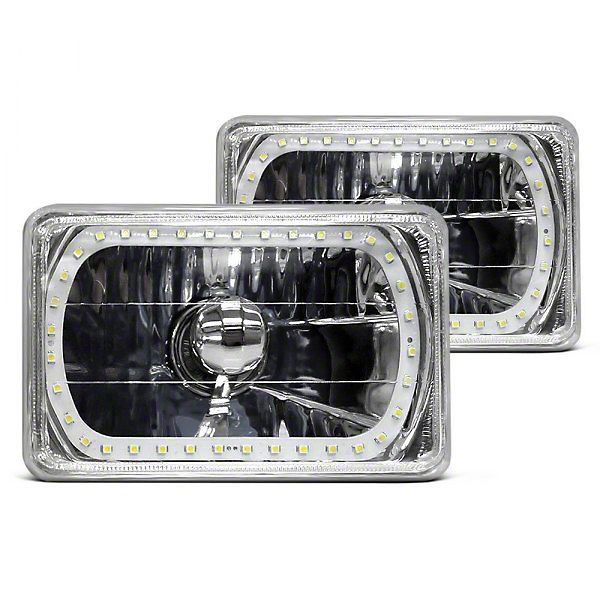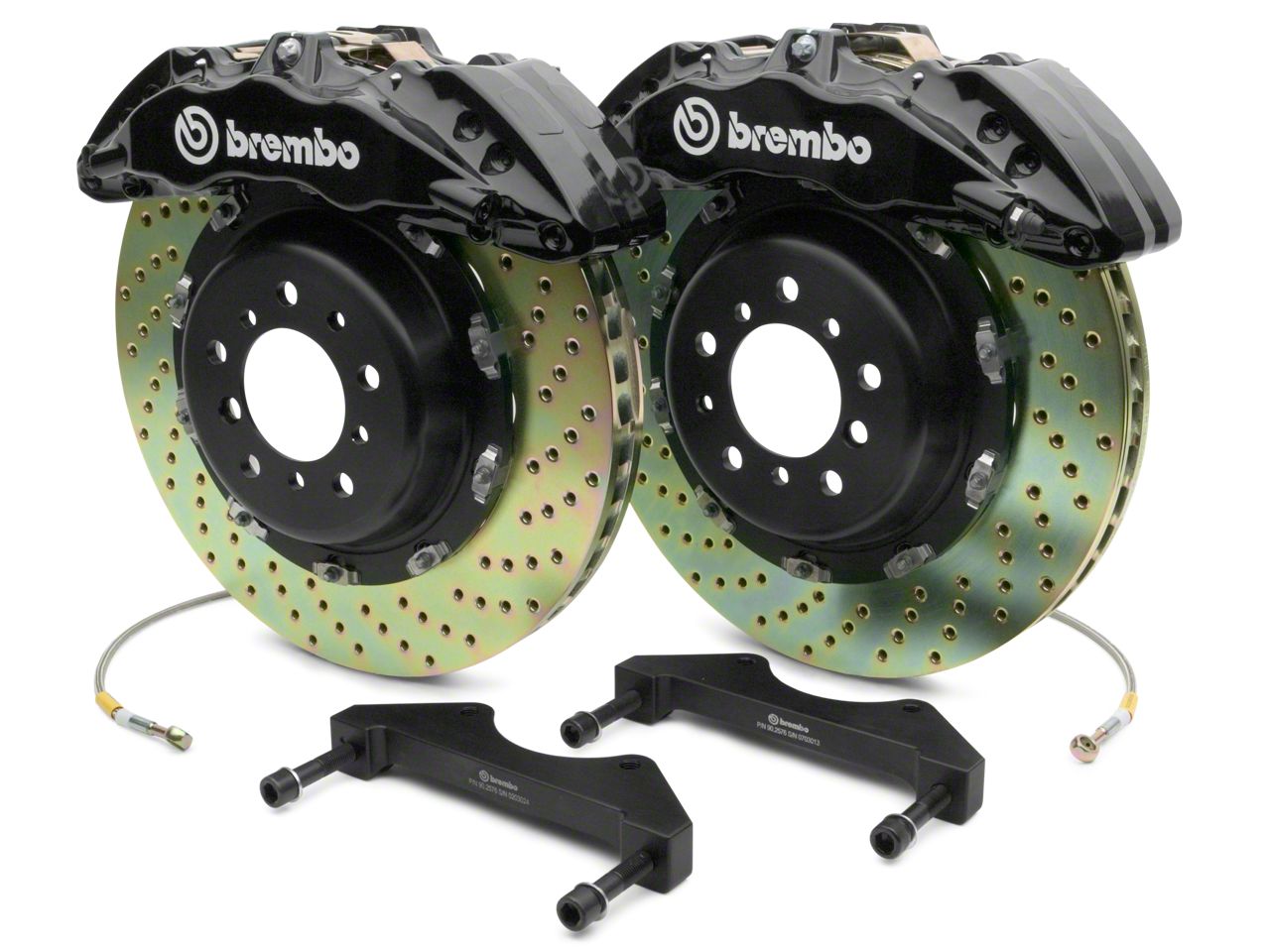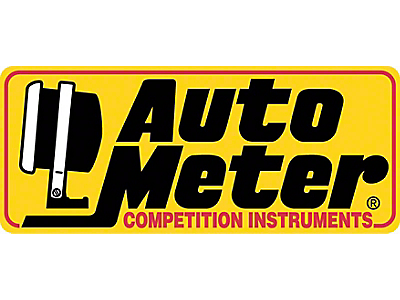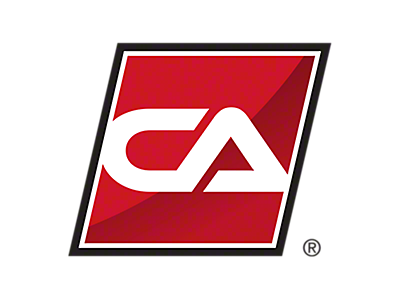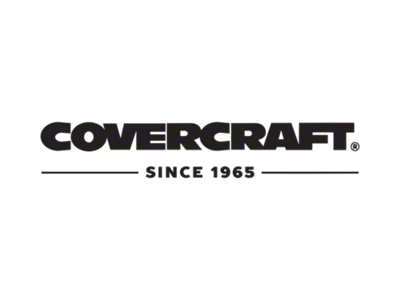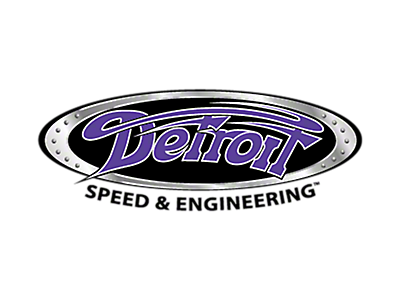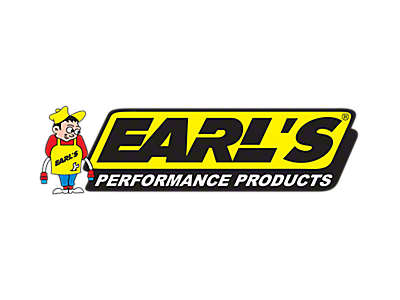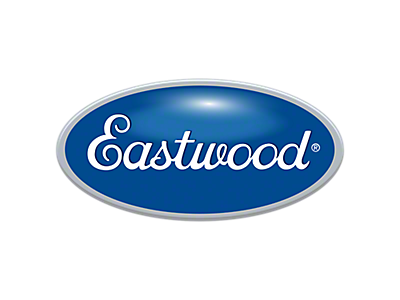'Classic Chevy Truck 1947-1959 CHEVY TRUCK HISTORY The Advanced Design After World War II Chevrolet came out with a stronger, larger truck, in 1947. This was the Advance Design. Available through to 1955, it came in three sizes, the half-ton, three-quarter ton and full ton, with short or long wheelbases. In 1947 the Chevy Advance Design did not have vent windows in the doors. The gas tank filler neck was located on the passenger side of the bed and the hood side emblems read Chevrolet with either Thriftmaster or Loadmaster underneath it. During this model year radios were available as an in-dash option on the Advance Design. Fresh air heater/defrosters were also available. The Advance Design pickup had a 90 horsepower 215.5 cu Thriftmaster OHV 6-cylinder engine. The three-quarter ton and the half-ton each had a 3-speed standard transmission, or the optional 4-speed, which was only available for the one-ton pickup. In 1948 the manual transmission shifter was relocated on the steering column, and the parking break was now a foot pedal on the far left, no longer a floor mounted lever. Double clutching was now a thing of the past with the replacement of the 4-speed spur-type transmission with a synchromesh. There were a few changes in 1949, such as the gas tank being relocated upright behind the back seat. Later that year the emblems were replaced with numbers to reflect the cargo capacity of each truck, such as the 3100 on the half-ton, 3600 on the three-quarter ton, and the 3800 on the one-ton, with CHEVROLET as the side hood emblems. Thriftmaster, on the side hood emblems, was no longer used. 1950 saw the addition of telescopic shock absorbers instead of lever-action, and in 1951 vents were added to the windows. This was the last year for the 80 MPH speedometer, chrome wiper knobs and chrome door handles knows on the windows, and also the year when the bed was changed from a 9-board to an 8-board layout. 1952 saw the introduction of push button outer door handles and a new 90 MPH speedometer, as well as painted dashboard trim, and maroon window and wiper knobs. The 3100-6400 designation on the hood was dropped. There was no rear bumper offered. In 1953 the 215 cu engine was dropped. A rear bumper was now available and the side-mounted spare tire was offered for the first time as an option. All the wiper knobs were a maroon plastic and the ID door plate, previously black and silver, were now blue and silver in color. 1954 brought about several new changes in design. The windshield, once having a vertical strip down the centre, was now one curved piece of glass. The grille, dashboard and steering wheel design were updated ,the tail lights were now round and the carbo bed rails were straight horizontal. As for engines, the Advance Design now had a 235 in straight-6, and Hydramatic automatic transmission as available as an option for the light-duty trucks. The Advance Design was available through to 1955 when the new Early V8 pickup trucks were introduced. As for the look of the truck, two-tone cabs were available as an option for the first time, but the top had to be white. The design for 1955 was the same as 1954, but the hood-side emblem was now redesigned and the enclosed torque tube was replaced with an open driveshaft. The Chevrolet Task Force was introduced in late 1955 and was produced through 1959. It had the new wraparound windshield and an optional wraparound rear window on the deluxe cabs. 1955 was the first year that power brakes and power steering were available on GM trucks. A new 12 volt electrical system was in place and fenders had single headlights and a one-piece emblem below the horizontal line on the fender. During 1955 the Chevrolet Cameo Carrier was also introduced. It was a two-toned truck with automatic transmission , a V8, and fiberglass panels which were added to the Chevy steel carbo-box. While not exactly a popular model or big seller, it had style and elements of that style could be seen later in the Ford Styleside, Dodge Sweptside and the Chevy’s Fleetside. A chrome grille, full wheel covers and chrome bumpers were standard on the Cameo. In 1956 the Task Force got a wider hood emblem and lost its egg crate grille design. In 1957 the hood was flattened out and the fender emblems were oval instead of a script design. In 1958 the light-duty trucks were renamed the Apaches, medium-duty trucks named Vikings and heavy-duty trucks called Spartans. The trucks were given four headlights and a wider, shorter grille, with parking lights available in the grill. Factory-equipped air conditioning was now available. The 1958 Chevy truck design would barely change in 1959, other than a nicer, larger hood emblem and the badging on the fenders having a new design. fun facts: 1947-1955 (1st series) Named: Advance-Design series 1947-1955 Chevy Trucks number one in sales 1947 Chevy Truck launch date was Saturday June 28 1947 1955 (2nd Series) - 1959 Named: Task-Force First time options for power steering and power brakes 12-volt electrical system First offering for a V8 engine First offering for the beautiful and iconic Cameo Cameo only truck featured with retractable tailgate cables 1960-1966 CHEVY TRUCK HISTORY GM introduced the categories for the trucks, to replace the 3100, 3200 and 3600 designations The Chevy Trucks between 1960-1966 did not have much differentiating each year, but there were several firsts, including the drop-center ladder frame resulting in a lower cab. The Chevy C/K was part of the Chevrolet and GMC full pickup truck line until 1998. A “C” or a “K” in front of the designation indicates whether it is a 2- or 4-wheel drive. 1960 trucks were available in Wideside (Fleetside/smooth) and Fenderside (Stepside/fendered) versions. In 1960, GM introduced the categories for the trucks, to replace the 3100, 3200 and 3600 designations. Now there was the 10 (for the ½ ton), 20 (for the ¾ ton) and 30 for the 1 ton model. The badges on the trucks were carried over from previous years, such as the 10 to 40 series labelled as the Apache, the 50 to 60 series called the Vikings, and the 70 to 80 series called Spartans. While Chevrolet used the C/K naming convention, GMC did not use it, opting to use 100, 1500, 2500 and 300 for the ½ ton, ¾ ton, 1 ton and 1 ½ ton respectively. From 1960-1962 model years, the Chevrolet trucks had torsion bar front suspension and trailing arm rear suspension. The 1962 lineup included the Corvair, 6 12 and 8-foot Fleetsides and Stepsides, an 8-foot ¾ ton and a 9-foot Stepside 1 ton. There were only two trim lines, custom and base. Engines available were the GMC 305 cu in V6, 236 cu 3.9-liter with 135 horsepower, a 261 cu 4.3-liter with 150 horsepower, and a 283 cu 4.6-liter V8 with 185 horsepower. In 1963 a new grille and a new base 230 cu 3.8-liter 140 horsepower, along with an optional 292 cu 4.8-liter with 165 horsepower was introduced. Coil springs replaced the light-duty truck’s torsion bar front suspension. Both the Chevrolet 1.4 ton C40 and the GMC 300 were discontinued during this year. The 1964 Chevrolet cab was changed. While the body itself didn’t change at all, there was now a new front grille, a curved windshield, and the interior was modified slightly. Standard engines were still the 230 and the 292 6-cylinder, while the 235.5 and the 261 sixes were both discontinued. C/K trucks could still get the 283 cu V8 as an option. Other than this, from 1964 to 1966 there were even fewer changes. fun facts: First for drop ladder frame GMC refereed to "Fleetside" as "Wideside" and "Step-Side" as "Fender side". GMC base engine was a 305 C.I. V6 making 135 hp 1967-1972 CHEVY TRUCK HISTORY 968 the GMC lettering was gone from the crossbar and the grille was redesigned The Action Line of C/K trucks launched in 1967, with more comfort and options than before, including new body sheet metal and a coil spring trailing arm rear suspension for more comfortable rides. The GMC models had leaf springs as a standard feature with optional coil springs, with the 4-wheel drive models of both Chevrolet and GMC had leaf springs on both axles. With 1968 came the new side-marker reflectors on the fenders, while the C40 and C60 trucks kept the small rear cab window, it was now discontinued for the other models. For 1968 the GMC lettering was gone from the crossbar and the grille was redesigned. Two new interior packages were available; the Convenience and the Custom Comfort. 1968 was also the 50th anniversary of Chevrolet’s truck manufacturing. A special 50th anniversary package which included a white-gold-white paint job was produced. The 2-wheel drive Longhorn ¾ truck debuted in 1968 as well. It had an extra 6 inches on the bed and a 133-inch wheelbase. There were several new changes in store for 1969. The 327 cu V8 was kicked up to 350 cid with a horsepower of up to 200, both Chevrolet and GMC trucks received a new hood shape and the Chevrolet got a new grille design. The new 1969 K5 Blazer was introduced as a new utility vehicle and the GMC Jimmy premiered. Inside the trucks there were several interesting changes, including the addition of a foot pedal break, replacing the hand-operated parking brake, and the replacing of the 3-spoke steering wheel and chrome horn button with a 2-spoke steering wheel with plastic horn button. Those who wanted a 2-tone look were now able to choose from lower and upper side moldings. 1970 Chevrolet trucks really didn’t look very different from the 1969 models, aside from the new grille, and even the 1969 and 1970 grilles are remarkably similar except for the addition of highlights that make the grille appear to be divided into six parts. Along came 1971 with a truck load of changes. The new egg crate design grille was part of the new look for the Chevy truck, and a new trim package, the Cheyenne, was available for the Chevrolet; also known as the Sierra for the GMC models. The Cheyenne and Sierra trim package included luxuries such as new carpet, chrome trim, a better interior with more padding and better insulation, lower and upper side moldings and tailgate trim. Disc brakes were now on all light-duty trucks this year and AM/FM radios were installed in the factory. For 1972 there were very few actual changes to differentiate the 1972 and the 1971 models. The rear view window was moved from the top of the cab to the windshield. The window and door cranks were a little longer, and metal and vinyl flat door panels were no longer available. Door panels were now molded plastic for all trim levels, with the Cheyenne and Sierra trim having integral armrests and inserts of wood grain for both the Sierra and Cheyenne trims. fun facts: This generation known as "Action Line" 1967 only year for the "small rear window" 1969 first year for the iconic small block 350 in trucks 1971 first year for factory installed AM/FM radio 1973-1987 CHEVY TRUCK HISTORY This was the era of the square-body (or box-body) truck 1973 was a big year for redesigns of the GM Chevrolet and GMC C/K Series trucks. This was the era of the square-body (or box-body) truck. There was a Rounded-Line of GM trucks, which had rounded corners on the windshield, cab roof, and doors, more comfortable seating and louvers behind the hood for better ventilation. The front fenders were slanted and the tail lamps wrapped around, which really stood out in combination with the new curved shoulderline that flowed across the back tailgate on both GMC Wideside and Chevrolet Fleetside models. The rounded-line generation would be produced through to 1987. Buyers had the choice of two boxes: a full width pickup box with a flared shoulderline and round wraparound tail lamps, with either steel or wood floor, known as the Fleetside by Chevrolet and the Wideside by GMC; and a narrow width pickup box with exposed fenders, steps, and standalone tail lamps, and the option of a wood floor, known as the Stepside by Chevrolet and the Fenderside by GMC. The Crew Cab 1-ton 3+3, the “Big Dooley” was also introduced in 1973. Four-wheel drive became standard on all V8s in 1974. As for design changes, there was an aluminum panel added to the center of the tailgate. For 1975 the trim levels were the basic Custom Deluxe/Sierra, a mid-range trim line known as Scottsdale/Sierra Grande, and a luxury trim package known as Cheyenne/High Sierra. The best, however, was now the Silverado/Sierra Classic. These trim levels continued through to 1987, but in 1982 the luxury trim levels were discontinued. It was in 1975 that the dual front lap-and-shoulder seatbelts were introduced. They had emergency locking retractors for outboard occupants, and a new center safety belt, complete with slack adjustment, was available for a center occupant. Other new features included new tempered and safety glass, prismatic rearview window, and new 6 turn-signal indicator lamps with asymmetrical flash and 4-way hazard light functionality. For 1975 Chevy trim levels were changed again. There were now new grilles and, instead of orange turn front turn signals, there was a clear-to-white design. A new woodgrain dash accent on the passenger side, along with plaid upholstery, was now part of the base model. As for engines, a 400cu 6.6-liter small-block V8 with 185 horsepower was added to the Chevy line. Other than a new voltage meter replacing the ammeter and the removal of engine size decals from the grille, the 1976 models did not have a lot of changes. There were optional deluxe chrome bumpers with rubber impact strips, and the Rally wheels were an option. Those wanting to save some money could now opt for a Bonanza trim package. Chevy Blazers now had an integrated roll bar, as well as a metal roof over the front seats and fiberglass roof over the back seats. The Bonus-Cab, with extra space for passengers, was new for 1976. In 1977, however, there were not only new grilles, a 4-wheel drive, full 1-ton chassis was now added to the lineup. This was when the power door locks and power windows were available as options. There were new flat dash trim panels, and base models had new flat stainless hubcaps. Models with a bed now had fuel doors to disguise the fuel caps. C30 1-tons, called the K30s, now offered 4-wheel drive, like the C10 and C20. They had a 4,500-lb front driving axel, a modified 7500-lb rear axle, a 4-speed transmission and power steering. The 1979 Chevrolet and GMC got a new grille and an interior facelift, with new seat trim and a new white and grey color option on the higher series called Mystic by GMC and Oyster by Chevrolet. The blue interior would be a shade darker in 1980. Also in 1980 higher end trim levels of Chevrolet truck had near-flush square headlights, new turn signals, and a new grille. Fuel economy was a big issue after the 1979 energy crisis, and things had to change. In 1981 fuel efficiency was a priority, so the Rounded-Line C/K Series trucks got a new aerodynamic redesign to make the front “bow-like”, which also helped drop the weight of the truck by close to 300 pounds. In California a 350 cu 5.7-liter pushrod V8 was offered instead of the 305 engine with electronic spark control. K-Series pickups received a new shift-on-the-move 4-wheel drive system with 2-speed dual range New Process 208 aluminum transfer case, instead of the old 4-wheel drive system. This system included automatic self-locking hubs and gearing that made it possible to shift the truck from 2-wheel drive to 4-wheel drive when traveling up to 25mph. Drive modes included Two High, Four High, Neutral and Four Low. The new 4-speed Turbo-Hyrdramatic 700R4 with overdrive gearing was introduced for 1982, as well as the 379 cu 6.2-liter 151 horsepower Detroit Diesel V8. In 1984 quadruple headlights were now optional. Hood ornaments were gone and the wiper control, high beam lights and cruise control were now on the turn signal stick. The Vortec V6 with 4-barrel carburetor was introduced in 1985, but 1986 was the last year Chevrolet truck engines would have carburetors. 1987 was the final year of the more conventional cab pickup trucks. In this year the Rounded-Line C/K-Series was renamed, simply, the R-V-Series, with the R-Series meaning 2-wheel drive and the V-Series referring to 4-wheel drive. In 1958 the light-duty trucks were renamed the Apaches, medium-duty trucks named Vikings and heavy-duty trucks called Spartans. The trucks were given four headlights and a wider, shorter grille, with parking lights available in the grill. Factory-equipped air conditioning was now available. The 1958 Chevy truck design would barely change in 1959, other than a nicer, larger hood emblem and the badging on the fenders having a new design. fun facts: This generation is also known as "Square Body" or "Box Body" trucks First for radio antenna embedded in windshield 1982 Detroit Diesel V8 replaced the antiquated LF9 Oldsmobile diesel engine. 1987 C/K series renamed R/V series 1988-98 CHEVY TRUCK HISTORY 1988 was the introduction of the fourth generation of GM trucks 1988 was the introduction of the fourth generation of GM trucks, with all new independent front suspension (IFS). Eight C/K trucks were available, including the Fleetside Single Cab, Fleetside Extended Cab, Fleetside Crew Cab and Stepside Single Cab. All came with either 2-wheel drive or 4-wheel drive, and would have independent front suspension. Visually, there were there were three trim levels offered, the Silverado, Scottsdale, and the Cheyenne. Under the hood four different engines, 4.3-liter V6, 5.0-liter V8, 5.7-liter V8,, 6.2-liter diesel V8, and a 7.4-liter V8 that was also available for the 1-ton and ¾ ton trucks. The GMC 3500 EFI 454 was available, kicking out 230 horsepower. In 1989 a limited run of a half-ton 2WD Sport package was introduced, mainly to see how well consumers would like it. This was a trim and towing package not really available on other Chevy trucks. It offered black and red bumper and body trim, a red outlined Chevrolet emblem on a new black grille, custom center caps on new chrome wheels and custom fog lights. During this same year a 4x4 sport appearance package was also available, with a sports grille, mirrors, wheel flares, black bumper and body trim, a 4X4 badge on the box and the word SPORT on the tailgate both with red-outlined Chevy bow tie emblems, as well as 16-inch cast-aluminum wheels. This sports package was available through to 1992, and was available with the regular Fleetside box and the standard cab. As for colors, they were limited to white, red and black. The Crew Cab 1-ton 3+3, the “Big Dooley” was also introduced in 1973. A special Sport package was available for Fleetside Chevrolet trucks in 1989 as well. Along with body-colored striped molding, body-colored bumpers, blacked out grille, chrome-plated steel wheels and chromed plastic center caps, it also included a standard Chevrolet Receiver hitch. An improved, stronger brake package and oil and transmission cooling lines were also included. While only 5400 1989 Silverado sport trucks were produced, it came back in 1990 with composite headlights and new sport emblems. 1990 saw the introduction of the Work Truck (W/T), with Cheyenne trim and a single cab long bed, black bumpers and a new grille. In 1991 ¾ ton and 1-ton trucks could now have the 4L80-E automatic transmission. The 4-speed manual transmission would be discontinued in 1992. A 6.5-liter diesel V8 with a turbocharger was now available, as were Stepside trucks with extended cabs. The 454SS, a GMT400 produced under the Super Sport emblem, premiered in 1990. This 2-door ½-ton short box had a 7.4-liter V8 with 230 horsepower, 3-speed Turbo Hydra-Matic 400 automatic transmission and a 14-bolt semi-floating axle. It was only available in Onyx Black and featured special rims, 454SS decals on the side of the bed, a black grille, bumpers and mirrors, a front air dam and fog lights. Inside were high-backed plush reclining sport bucket seats and a center console, all done in a Garnet Red with black trim. The 4L80E 4-speed automatic transmission would be added to the Chevrolet 454SS, along with a new tachometer and dual exhaust. Numerous interior colors and two new colors would become available in 1992-1993, Victory Red and Summit White. The decals on the tailgate and the rear quarter panels were changed to a more modern SS in 1992. The C3500 HD was introduced by GM in 1991. It had a standard chassis cab, and a Dana 80 drive axle. The HD frame is definitely heavier than the C/K3500, and stretches out behind the high mounted cab. Truck buyers could choose between the 4L80E 4-speed OD automatic transmission and the NV4500 5-speed manual transmission. From 1991 through to 1995 the C3500 HD pickup came with either a 7.4-liter GEN V big-block motor or a 5.7-liter 3500 small-block. Both of these engines would be replaced by the Gen VI 7.4-liter Vortec big-block engine in 1996. While there was the C3500 HD, GM did not produce a K3500 HD version. The new 4L60E transmissions were part of the 1500 and 2500 series trucks in 1993. On the outside was a new two-tone look, folding exterior mirrors, and a new satin textured finish on the door handles. In 1996 extended cab models now had the option of a passenger-side third door. In 1998 the C/K no longer had CHEVROLET across the back tailgate. There weren’t a lot of major trim changes for this year. The GMT400 trucks were being manufactured as the Sierra Classic/Silverado Classic until 2002. fun facts: First time all independent front suspension used In truck 1987 first time driver side air bags used in trucks 1990 introduction of 454 Super Sport
Sales Techs Available: 1-877-305-8966
Talk to a Corvette Sales Tech
1-877-305-8966
M-F 8:30A-11P, Sat-Sun 8:30A-9P

